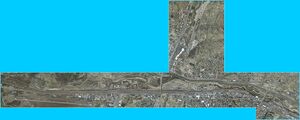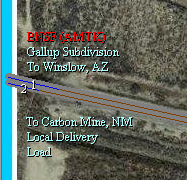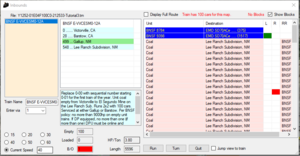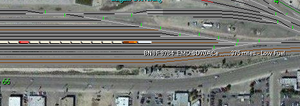Tutorial 3 - Unit Coal at Gallup NM
While Tutorial 1 - Switching at Rolla CO and Tutorial 2 - Local Work at Bowling Green KY covered "manifest" traffic, where trains carry a mix of cars for different origins and destinations, this tutorial covers the concept of unit trains, which carry a single type of traffic from origin to destination, without any need for switching at classification yards. It will also cover how and when to fuel locomotives, repair cars, and how "virtual" maps (also known as virtual IDs or vIDs) work.
Setup
The second tutorial will take place on the NM:Gallup 1252 map. As before, you will need to download the relevant map by selecting it in the Maps and Trains window and pressing the Download Map button - see Tutorial 1 if you need a refresher on this.
There is a single train for this tutorial. If you have not yet been registered, you will find it listed as a file beginning with Y1252 with Tutorial3. Alternatively, all tutorial trains can be downloaded by unregistered or registered players by selecting "Download Tutorial Trains" in the "Tutorial" menu on the toolbar.
An overview of Gallup
Gallup, NM is located on BNSF's Southern Transcon, their mainline between Chicago and Southern California, seeing around 100 trains a day. Gallup is located in western New Mexico, near the border with Arizona, with the yard serving as a base for local traffic in this remote corner of the state.
As with Bowling Green KY in Tutorial 2, Gallup NM is assigned multiple map identities in FYM: Gallup itself, Carbon Mine NM, the Lee Ranch Subdivision NM, and Zuni NM. Only Gallup NM is represented in game with playable track; the other three map identities are virtual maps. Virtual maps are used in FYM to represent parts of the network that are not directly mapped for one of several reasons:
- No good aerial imagery exists from which an FYM map can be created - even in the modern day, many remote areas still only have poor resolution imagery
- The industries along a line are too spread out or few in number to make a good, interesting map from
- Virtual maps require less player time to operate; we only have a limited number of players to operate maps
A virtual ID is indicated in FYM by an additional set of light blue labels near to a map exit. At Gallup, the label for Carbon Mine is at the left end, below exits 1 and 2, while those for Zuni and the Lee Ranch Subdivision are at the right end, above exits 3 and 4. The labels indicate the name of the virtual ID, the phrase "Local Delivery" to indicate that they refer to a virtual ID where cars must be sent off the map for delivery, and either one or both of "Load" and "Unload". These latter two labels can be clicked on to bring up the list of cars handled by the virtual ID, just like a normal siding.
Virtual IDs are also indicated on the Connection Map, being displayed as hollow circles. If you need a reminder on downloading and viewing connection maps, see the section on them in Tutorial 2.
| Label indicating the virtual ID for Carbon Mine, NM, and the Lee Ranch Subdivision at the west (left) end of the map. The 'Load' label can be clicked on to see what cars can be loaded. | Connection map for New Mexico in the area around Gallup. The three virtual IDs are shown as hollow circles, connected to their parent map (Gallup) by a white outline. |
Unit Coal Train
After you have downloaded the train file for Tutorial 3, you should find a single empty coal train listed in the Inbound Trains window (hotkey Ctrl-Z). The train consists of 100 empty coal cars returning to El Segundo Mine (located on the Lee Ranch Subdivision), to be loaded for the CEMEX's Victorville Cement Plant. Four locomotives are powering the train, operating in 2x2 DPU configuration - two leading the train, and a further two pushing from the rear. On viewing the train in the Inbound Trains window, there are three items worth noting:
- Two locomotives (8784 and 9982) have low fuel, with only 375 miles remaining; the other two units are relatively low, at 1517 (FYM assumes a relatively large range of 3000 miles on a full tank of fuel)
- In each pair of locomotives, one is shown with a green mark, indicating that it is "Dead-in-Tow". This means it is turned off in order to save fuel, explaining why two of the units have fuller tanks of fuel
- One car in the train is shown with a red mark, indicating that it is bad ordered and requires repair before it can be loaded. Echoing this information, the summary of the train at the bottom center of the window shows that there is 1 B/O (bad order) car.
As the train needs fueling and repair before it is sent for loading, set a route from Exit 1 (where the train is entering) into Gallup Yard. The switch leading into the yard is located near exit 1 at CP West Gallup, leading from the brown main lines onto the black track labelled "West Long Lead". The train will fit on any of the long yard tracks.
Re-open the Inbound Trains window and bring the train in; you may also wish to select a lower speed than the 40mph it is entering at, perhaps 15 or 20mph. When the train enters the map, there are various indicators of the need for fuel and repairs:
- An on-screen message will remind us of some important information about the train - that it terminates here (and has 100 cars for loading), that it has a Bad Order car needing repair, and two locomotives are low on fuel (<500 miles remaining).
- Locomotives low on fuel will have a flashing marker, and when you move your mouse over them will show "Low Fuel"
- Bad order cars can be seen in Filter 4 (press 4 on the keyboard to enable this), indicated by flashing red, and when you move your mouse over them will show "Bad Order".




